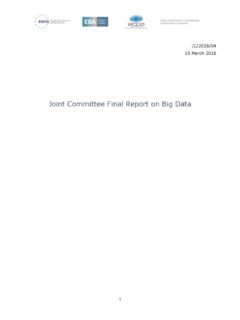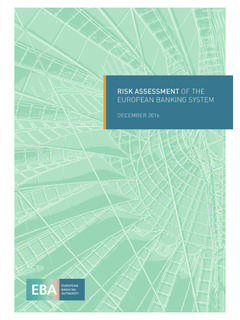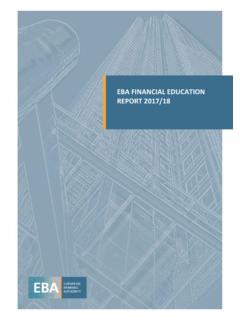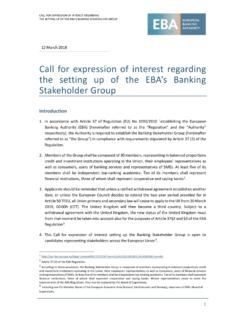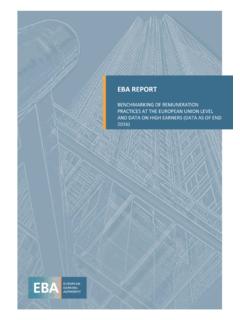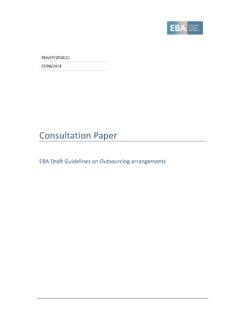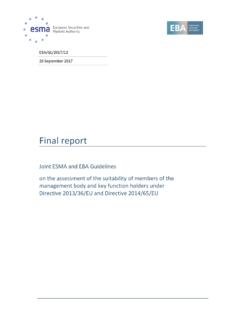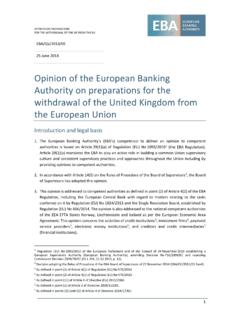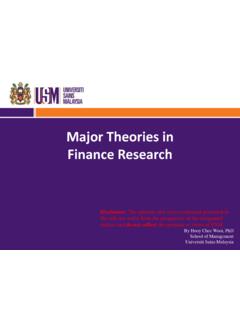Transcription of ON MANAGEMENT AND SUPERVISION OF ESG RISKS FOR …
1 EBA REPORT ON MANAGEMENT AND SUPERVISION OF ESG RISKS FOR CREDIT INSTITUTIONS AND INVESTMENT FIRMS EBA/REP/2021/18 EBA REPORT ON MANAGEMENT AND SUPERVISION OF ESG RISKS FOR CREDIT INSTITUTIONS AND INVESTMENT FIRMS 2 Contents List of figures 4 List of tables 5 Glossary 6 Abbreviations 8 Executive summary 10 1. Background and rationale 14 Structure of the report 19 2. Common definitions of ESG factors, ESG RISKS and their drivers and transmission channels 22 Definition and general features of ESG factors 27 Definition of ESG RISKS 32 Environmental factors and environmental RISKS 34 Environmental factors and environmental RISKS 34 Physical risk 36 Transition risk 38 Interaction between physical and transition RISKS 42 Social factors and social RISKS 43 Governance factors and governance RISKS 47 3.
2 Quantitative and qualitative indicators, metrics and methods to assess ESG RISKS 50 Quantitative and qualitative indicators for the identification of ESG RISKS 55 Methodological approaches for assessing and evaluating ESG RISKS 61 Portfolio alignment method 62 Risk framework method 66 Exposure method 71 Comparison of methods and their application 75 4. MANAGEMENT of ESG RISKS by institutions 80 Business strategies and business processes 82 Current practices 84 Monitoring the changing business environment and evaluating long-term resilience 87 Setting strategic ESG risk-related objectives and/or limits 89 Engaging with counterparties and other relevant stakeholders 91 Considering the development of sustainable products 93 Internal governance 97 Current practices 97 MANAGEMENT body and committees 99 Internal control framework 101 Remuneration 103 EBA
3 REPORT ON MANAGEMENT AND SUPERVISION OF ESG RISKS FOR CREDIT INSTITUTIONS AND INVESTMENT FIRMS 3 Risk MANAGEMENT framework 106 Current practices 106 Risk appetite, risk policies and risk limits 110 Data and methodology 113 Risk measurement, monitoring and mitigation 117 The climate risk stress testing framework for banks 119 (i) Main challenges of a climate risk stress test framework 119 (ii) Main practices for climate risk stress test 120 Specific considerations for investment firms 124 5. ESG factors and ESG RISKS in SUPERVISION 128 Scope of supervisory review in the CRD and the IFD 129 Main links between ESG factors.
4 ESG RISKS and supervisory review 130 ESG RISKS in business model analysis 132 Business environment and long-term resilience 133 Understanding the current business model from an ESG RISKS perspective 134 Analysis of the strategy and financial plans 135 Assessing business model viability and sustainability 136 ESG risk-related considerations as longer term resilience of the institution s strategy 137 Internal governance and institution-wide controls 139 Overall internal governance framework 139 MANAGEMENT body, corporate and risk culture 140 Remuneration policies and practices 141 Internal control framework 141 Risk MANAGEMENT framework 141 Information systems 142 Assessment of risk to capital 143 Assessment of credit and counterparty risk 143 Assessment of portfolio credit quality (with focus on loan origination)
5 145 Assessment of market risk 146 Assessment of operational risk 147 Risk identification, measurement, monitoring and reporting of social and governance RISKS 148 Assessment of RISKS to liquidity and funding 148 SREP capital assessment 150 Annex 1 Non-exhaustive list of ESG factors, indicators and metrics 152 Annex 2 Feedback received on the Discussion Paper and main changes in the report 163 EBA REPORT ON MANAGEMENT AND SUPERVISION OF ESG RISKS FOR CREDIT INSTITUTIONS AND INVESTMENT FIRMS 4 List of figures Figure 1 Main content of this report 21 Figure 2 Commonalities of ESG factors 28 Figure 3 Visualisation of the relationship between institutions and ESG factors through the outside-in and inside-out perspecives 30 Figure 4 Summary of ESG risk drivers.
6 Their transmission channels and how these can impact financial risk categories 34 Figure 5 Theoretical example on the ESG cycle: impact of environmental factors through physical risk on credit institutions' balance sheets and investment firms' balance sheets 37 Figure 6 Theoretical example on the ESG cycle: impact of environmental factors through transition risk on credit institutions' balance sheets and investment firms' balance sheets 40 Figure 7 Theoretical example on the ESG cycle: impact of social factors on institutions' balance sheets 47 Figure 8 Challenges of incorporating ESG RISKS 52 Figure 9 Approach to the assessment of ESG RISKS 53 Figure 10 Sources that refer to ESG indicators 60 Figure 11 Overview of the three methodological approaches 76 Figure 12 ESG in business strategies and processes 84 Figure 13 Incorporation of ESG RISKS at the point of loan origination 102 Figure 14 Links between ESG factors and supervisory review 130 EBA REPORT ON MANAGEMENT AND SUPERVISION
7 OF ESG RISKS FOR CREDIT INSTITUTIONS AND INVESTMENT FIRMS 5 List of tables Table 1 Examples of ESG factors included in the most commonly used frameworks 26 Table 2 The three methodological approaches in the context of loan origination and portfolio MANAGEMENT 27 Table 3 The three methodological approaches: pros and cons 79 Annex 1 Table 1 Environmental factors 156 Annex 1 Table 2 Social factors 158 Annex 1 Table 3 Governance factors 161 EBA REPORT ON MANAGEMENT AND SUPERVISION OF ESG RISKS FOR CREDIT INSTITUTIONS AND INVESTMENT FIRMS 6 Glossary Climate-related RISKS Climate-related RISKS are the financial RISKS posed by the exposure of institutions to counterparties that may potentially contribute to or be affected by climate change.
8 Climate sensitivity analysis An exercise without scenarios, assessing changes in portfolios risk attributes by changing some of the inputs in financial models based on shading and classification of exposures into green versus non-green (which determines an exposure s vulnerability to climate-related events and policies). Climate stress test Assessment featuring fully fledged scenarios that map out possible future development paths of transition variables ( carbon prices), physical variables ( temperature increases) and the related changes in macro variables ( output in different sectors, GDP, unemployment) and financial variables ( interest rates).
9 These scenarios are then translated into changes in portfolio (risk) attributes. Environmental factors Environmental matters that may have a positive or negative impact on the financial performance or solvency of an entity, sovereign or individual. Environmental RISKS The RISKS of any negative financial impact on the institution stemming from the current or prospective impacts of environmental factors on its counterparties or invested assets. ESG factors Environmental, social or governance matters that may have a positive or negative impact on the financial performance or solvency of an entity, sovereign or individual.
10 ESG-related investment benchmarks Benchmarks which incorporate specific sustainability-related objectives and help to assess and compare the performance of sustainable investments over time. ESG RISKS ESG RISKS are the RISKS of any negative financial impact on the institution stemming from the current or prospective impacts of ESG factors on its counterparties or invested assets. ESG risk-related strategic objectives and/or limits Determinations which aim at managing an institution s exposure to ESG RISKS , over the short-, medium- and long-term time horizons.
